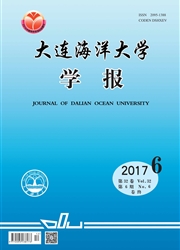

 中文摘要:
中文摘要:
研究了蓝光(A=436.67nm±4.8nm)、红光(A=625.38nm±6.3nm)、黄光(A=574.95nm±6.1nm)和绿光(A=547.43rim±4.3nln)对灰绿、暗红两种体色日本蜉Charybdisjaponica成蟹(头胸甲宽59.11~79.98mm)和同家系仔蟹(头胸甲宽8.9~9.8mm)摄食与生长的影响。结果表明:体色灰绿的“花盖”在蓝光和绿光中的摄食频率均高于其在另外两种光色中的(P〈0.05),而体色暗红的“赤甲红”在红光中的摄食频率明显高于其在另外3种色光中的(P〈0.01);绿光中仔蟹的成活率最高,但各颜色光照组间无显著性差异(P〉0.05);绿光组仔蟹的蜕壳率最高,仅与自然光组仔蟹相比有显著性差异(尸〈0.05);绿光组仔蟹体质量的特定生长率(SGR,)最大,明显高于其他各组(P〈0.05或P〈0.01);绿光与黄光中仔蟹的摄食率(F1)较低,但各组间无显著性差异(P〉0.05);绿光组仔蟹的食物转化效率(FCE)最大,与红光组有显著性差异(P〈0.05),与自然光组有极显著性差异(P〈0.01)。
 英文摘要:
英文摘要:
Effects of blue light(wavelength: 436.67 nm±4.8 nm), red light (625.38 nm±6.3 nm), yellow light (574.95 nm±6.1 nm) ,and green light (547.43 nm±4.3 nm)on growth and feeding were studied in adult (cara- pace width 59.11-79.98 mm) and sibling juvenile ( carapace width 8.9-9.8 mm) Asian swimming crab Charyb- dis japonica. Results showed that the " Huagai" Asian swimming crab with body color in green-gray showed signifi- cantly higher feeding activity in blue or green light than in other color( P〈0.05 )did. However, "Chijiahong" Asi- an swimming crab with body color in red had very significantly higher feeding activity under red light( P〈0.01 ). The maximal survival rate was observed in the juvenile swimming crab in the green light, without significant differ- ences under various color light, and the maxima[ molting rate was found in the green light, significantly different from that in natural light(P〈0.01 ). The juveniles had the maximal specific growth rate (SGR) in green light, sig- nificantly higher than that in yellow, red and blue light ( P〈0.05 ), as well as in natural light (P〈0.01). Howev- er, the Asian swimming crab showed lower food ingestion (FI) in yellow and green light than in the other light, without significant difference (P〉0.05). There was the maximal food conversion efficiency (FCE) in the crabs under green light, significantly different from that under yellow (P〈0.05) and natural light(P〈0. 01 ).
 同期刊论文项目
同期刊论文项目
 同项目期刊论文
同项目期刊论文
 期刊信息
期刊信息
